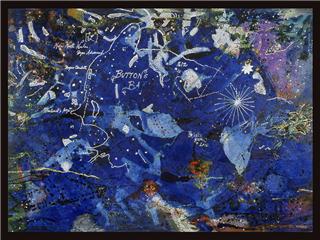January 10 – February 8, 2008
Landon Mackenzie
Houbart's Hope
An Artist's Talk with Landon Mackenzie will take place at the FOFA Gallery Friday, January 11 at noon.
Last chance Saturday — The gallery will be open the last Saturday of the exhibition (Saturday, February 9 only), from noon to 4 pm.
Concordia University's Faculty of Fine Arts Gallery (FOFA Gallery) is pleased to welcome Vancouver-based artist Landon Mackenzie (MFA 1979, Concordia) back to Montreal for her first show in the city since 2000. Known for her large-scale canvases, Mackenzie will exhibit works from her series Houbart's Hope .
The exhibition will be on view at the FOFA Gallery from January 10 to February 9, 2008. The vernissage will take place on January 10 from 6:00 p.m. to 8:00 p.m. at the FOFA Gallery (Concordia University, 1515 Ste Catherine Street West, EV 1-715, Montréal, metro Guy-Concordia). Mackenzie will speak about her work in the gallery on Friday January 11 from noon to 1 p.m.
In Houbart's Hope Mackenzie combines her interests in landscape, cartography and neuroscience. Although abstract in appearance, vestiges of historical maps and the process of cartography remain. Using unusual methods, she plays with the immense canvases (7'6" x 10'3") as a platform for her intuition and her ideas, deliberately constructing parallels of exploration. She considers both her archival research and her picture-making as a treasure hunt, a fairy tale and a way of synthesizing her rich intellectual and intuitive traits.
Québec audiences will be familiar with Landon Mackenzie's work having received critical acclaim for her contribution to the conceptual art and performance event 03 23 03 in 1977 while still a graduate student at Concordia University. She was then awarded First Prize in the Third Québec Biennial of Painting in 1981 for her Lost River Series . In 1996 and 2000 her large-format Saskatchewan and Tracking Athabasca paintings received generous praise when exhibited at Espace 502. This forthcoming exhibition will allow the Montreal audience to catch up on Mackenzie's more recent work and the third part of her trilogy of map paintings. Mackenzie's work has been collected by major museums including the National Gallery of Canada, the Vancouver Art Gallery, The Art Gallery of Ontario, the Montréal Museum of Fine Arts, and the Musée d'art contemporain de Montréal.

Artist's Statement
“In these works I am making propositions while crossing two frontiers. One being the territory of The New World and the search for the near-mythical North-West Passage starting around 1600 and to this day not fully resolved; and the other being the state of new exploration, uncertainty and discovery in neuroscience since the advent of digital imaging and its implications for a better understanding of the brain and nervous system. There are limits and conditions to how we picture phenomena that are shifting or metabolic in both the body and the world, and I see no reason not to participate.
“Houbart's Hope is a little-known landmark on Hudson Bay beginning in 1612 and vanishing generally by the 18th century. It marked a spot near the 60th parallel where Captain Thomas Button and his pilot Josiah Houbart believed the North-West Passage could be. So as with many of my projects, I combine historical ‘fact' with speculative fiction and continue on from there.
“I use painting as a method to sort things out; all the input of stimuli and information I take in need an output channel to remix it and plot it down in a way that works for me — a way to grapple with some pretty large subjects while leaving meaning open for others to consider when I exhibit the pictures. Being part of a discipline that is not geography and not science I have the advantage of working with the historical template of fiction. Both the earth and the brain have hemispheres, arteries, networks, deposits, branch-like forms, electrical, magnetic and chemical properties, so I can just start there.
“I usually work over long periods of time on several canvases simultaneously until stories and constructs begin to manifest a terrain or a pattern that I can follow, like a trail or a puzzle that provokes my imagination and my analytical mind during the process of building a picture. Unlike most representational painters of my generation, I don't use photographic source material, instead I refer to my own research, memory data bank, imagination, maps and diagrams.”
For more about Landon Mackenzie's work visit www.landonmackenzie.com

| 
